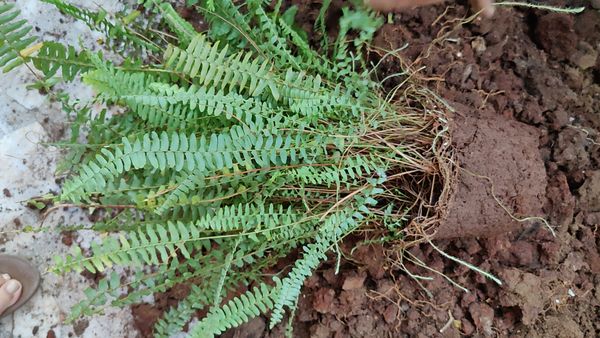Master the Art of Plant Health with Proper Fertilization Techniques
The Secrets of Plant Health: Unveiling the Power of Nutrients, Microorganisms, and Soil Welcome to our blog dedicated to unravelling the secrets of plant health! In this comprehensive guide, we will delve into the intricate relationships between plants, nutrients, microorganisms, and soil. Whether you're a seasoned gardener or just starting your green journey, these insights will help you nurture thriving plants.
Plants' Unique Nutrient Understanding Did you know that plants can only understand nutrients in an inorganic form? Organic nutrients must be converted into an inorganic form before plants can absorb them.
The Holy Trinity:
Soil, Microorganisms and Organic Manure
In any garden system soil, microorganisms and organic manure play a pivotal role. These three factors are vital for creating a healthy growing medium for plants. All these three things are very important for any growing medium for plants or any garden system, whether you apply fertilizers or you don't apply fertilizers they are very important.
1. The Soil's Hidden Role
Soil is a key player in the storage and uptake of nutrients by plants. It contains vital nutrients and features a unique structure that aids nutrient fixation. Clay soils and red soils have sheet-like structures that provide an ideal environment for nutrient storage. That is why Soil plays a crucial role as a medium for the rapid growth of plants such as vegetables, grasses, and seasonal plants. Organic matter like cattle manure, goat manure, and leaf litter contributes to this process, ensuring nutrients remain available to plants.
Cocopeat and Soil Mixture Cocopeat Cannot store these nutrients for months together. The moment you apply a fertilizer into a cocopeat-based system it is there for 3 days or 4 days because cocopeat systems are very loose, very very airy, and open. These nutrients get washed away in subsequent watering in about 4 to 5 days or 6 to 7 days, before even the nutrient is converted to an available form for plants to uptake. Cinder, much like sand, lacks a defined structure, making it suitable for plants with slow growth rates and low nutrient requirements. Varieties such as Champa, Adenium, Anthurium, Cacti, Bryophyllums, Aloe Vera, and Sansevieria thrive in such conditions. These resilient plants can flourish in cinder or sand-based mediums, as they rely on minimal nutrition for their steady development.
Adding one hand full of soil and organic manure like goat manure, sheep manure, cattle Manure will create the magic. A mixture of soil and cocopeat, combined with organic manure, ensures proper nutrient retention and availability for plants.
2. Role of Microorganisms in Nutrient Transformation Microorganisms are the unsung heroes of plant health. They break down complex substances in fertilizers and organic manure, converting them into forms that both they and plants can utilize. Incorporating microorganism-rich products like Azospirillum, Phospho bacter, Potash mobilizing bacteria, biofertilizers, panchgavya, jivamrut enhances soil health and nutrient availability.
3. Organic Matter
Once the micro-organisms have converted nutrients into available form there are two possibilities one it can be taken by the plant or wasted through drainage. Here is why your organic matter plays an important role. If you have a decent amount of organic matter like humus, cattle manure, goat manure, leaf litter manure, and vermicompost in your soil, the nutrients get stuck to the organic matter. It gets adsorbed. It gets fixed to the organic matter. It is not wasted and thus ensuring they're available for plant uptake.
All about plants Fertilization
Fertilizers are very important for plants which are super growers. Like seasonal flowers, seasonal vegetables and fruits. Without nutrition or fertilizers, it is very difficult to get extra flowers or vegetables and fruits, which we demand from plants. To a certain extent using fertilizers in a rational way is acceptable. It has nothing to do with going against nature.
Plants nurtured in nurseries undergo a distinct cultivation process, primarily utilizing cocopeat rather than sandy soil for growth. The nursery plants thrive due to meticulous applications of growth regulators like Gibberellic acid (GA) and fungicides, which stimulate development and safeguard against infections. This heavy reliance on hormones and fungicides results in vibrant nursery growth. However, upon transitioning to home environments, the absence of these treatments becomes evident within a month as the plants exhibit signs of decay and stunted growth, underscoring the contrast between nurtured nursery conditions and the less controlled home settings.
Therefore it becomes necessary to learn: How to make plants healthy in home gardens?
And remember Fertilizers are very safe for plants, it is pesticides which are not safe. Fertilizers given in the right quantity, on time and in a right way work wonders. So, let’s know all about them.
The world of fertilizers encompasses three main categories: Straight fertilizers, mixed fertilizers, and complex fertilizers.
- Straight fertilizers,
Straight fertilizers are designed to supply specific nutrients directly to plants. Examples include Potash and Epsom salt.
Epsom salt, or magnesium sulfate, is a notable straight fertilizer that provides magnesium directly to plants. Magnesium, a vital component of chlorophyll, contributes to the vibrant green colour of leaves and enriches overall plant health. Additionally, sulfur present in magnesium sulfate aids in promoting flowering, particularly during favourable flowering seasons. Notably, magnesium is situated at the core of the chlorophyll molecule within leaves, surrounded by four nitrogen atoms. This strategic addition of magnesium to plants enhances chlorophyll production and ultimately leads to the development of lush and visually appealing leaves. To capitalize on these benefits, it is recommended to apply Magnesium sulfate, or Epsom salt, two to three times a year.
However, it's important to exercise caution when utilizing straight fertilizers, as they contain high concentrations of nutrients. Home gardeners should be aware that these fertilizers possess the potential to induce toxicity or burning symptoms in plants due to their potency.
2. Mixed Fertilizers
In contrast, mixed fertilizers represent the second category, offering a more balanced nutrient profile. A prime example is Rose mix, known for its slow-release nature. These fertilizers contain moderate levels of essential nutrients, typically around 6-8% of nitrogen, phosphorus, and potassium (NPK). Brands such as Osmocote specialize in mixed fertilizers with NPK ratios ranging from 6 to 8%, ensuring optimal nourishment for plants over an extended period.
Mixed fertilizers like rose mix are best for home gardens, not only for roses but for all plants' requirements.
3. Complex Fertilizers
Lastly, complex fertilizers introduce various combinations of NPK elements, such as the well-known formulation 19:19:19 or 17:17:17. These fertilizers are meticulously crafted to deliver a balanced blend of nitrogen, phosphorus, and potassium, catering to the multifaceted nutritional requirements of plants.
Essential Macronutrients for Plant Growth Plants require six major nutrients to thrive: nitrogen, phosphorus, potassium, calcium, magnesium, and sulfur. These nutrients play critical roles in various physiological processes within plants. However, among these, calcium, magnesium, and sulfur often require additional attention. Calcium is found in gypsum, while magnesium and sulfur are present in Epsom salt. Applying Epsom salt and gypsum every 4 months, at a rate of 2 to 3 grams per pot, ensures an appropriate supply. Overapplication should be avoided, as it can lead to adverse effects on plant health.
The Role of Micronutrients Micronutrients is essential for plants in smaller quantities. Typically, deficiencies of micronutrients are less common in home gardens. Micronutrients include boron, zinc, manganese, iron, copper, and molybdenum. Micronutrients are naturally present in various organic products, such as cattle manure compost, Neem cake, mustard cake, and Neem Khali. These sources offer a sufficient supply of micronutrients for healthy plant growth and development.
It's prudent to keep a macronutrients packet on hand, as they have a long shelf life (around 1 to 1.5 years). This precaution is especially useful in the case of a potential micronutrient deficiency.
Organic Fertilizer: Bone Meal
Bone meal is an organic fertilizer rich in phosphorus, a nutrient essential for root development, flowering, and fruiting. It's particularly valuable for promoting strong root systems and overall plant health.
Very important points to Nurture Plants with Care
By following these guidelines and understanding the intricate interplay between nutrients, microorganisms, and soil, you'll unlock the secrets to vibrant and thriving plants.
1. Timing of Fertilization: Fertilization should ideally be performed after pruning or during the active growing stage, after the rainy season is over. . Within about 15 days of pruning, signs of new growth become apparent, indicating that this is the appropriate time for fertilizer application.
2. Frequency of Fertilization: For plants with a growing season of approximately 6 to 8 months, fertilizers are typically applied once every 2 months during the growing phase. This regular interval helps maintain a consistent supply of nutrients to sustain the plant's development and flowering.
3. Seasonal Plants and Vegetables: Seasonal flowering plants and vegetables experience a growth period of 6 to 8 months, accounting for a few months of dormancy in both winter and summer. During their active growth phase, fertilization every 2 months is recommended to ensure healthy development, vibrant flowering, and robust fruiting.
4. Perennial Plants: Perennial plants, like mango, chiku, and guava trees, have a longer lifespan and require fertilization once a year. This annual application should be timed about 4 to 5 months before the anticipated flowering season. Providing nutrients well in advance helps the plant build up its nutritional reserves, leading to optimal flowering and fruiting.
5. Papaya and Coconut Trees: Papaya and coconut trees differ from other trees in that they exhibit continuous fruiting. As a result, they require more frequent fertilization, approximately once every 2.5 months, to sustain their ongoing production of fruits.
6. Nutrient Convincement: Plants need to be sufficiently nourished to achieve their best flowering and fruiting potential. Fertilizers play a key role in "convincing" the plant that it has an ample supply of nutrients available. This nutrient assurance encourages the plant to allocate resources toward flowering and fruiting rather than focusing solely on survival.
7. Pre-Flowering Fertilization: For trees such as mango and guava, which have defined flowering seasons, applying fertilizers 4 to 5 months before the anticipated flowering season is essential. This proactive approach ensures that the plants have ample nutrients to support robust flowering and fruiting when the time comes.
8. Avoid fertilization during rainy season or monsoons
During the monsoon, there is an abundance of water due to heavy rainfall. When fertilizers are applied to the soil, they dissolve quickly and are carried away by the excess water. This results in a substantial loss of nutrients as the fertilizers are washed out through the drainage holes at the bottom of pots or containers.
During the monsoon season, plants tend to exhibit a slower growth rate and reduced metabolic activity. This can be attributed to factors like reduced sunlight and excess water. As a result, plants are naturally inclined to be in a resting state during this time.
Waiting until after the monsoon for fertilizer application, along with appropriate pruning and training, sets the stage for optimal plant growth and vitality.
9. Nutrient Movement in Plants
Nutrients such as Nitrogen, phosphorus, potassium, magnesium, sulfur, zinc, and copper are categorized as fast movers inside the plant system. So their deficiencies will be seen in the lower leaves of the plants.
Nitrogen deficiency primarily affects the lower leaves of the plant. The older foliage starts turning pale green or yellow as nitrogen, a fundamental element for chlorophyll production
In contrast, calcium (Ca) and iron (Fe) are considered slow movers in the plant's nutrient transport system. As a result, their distribution is comparatively sluggish, and so deficiencies of calcium and iron are often manifested in the upper parts of the plant, particularly in the upper leaves. The symptoms of calcium deficiency typically appear in various ways. One common example is the end of tomato fruit displaying signs of calcium deficiency, leading to issues like blossom end rot. This deficiency manifests as a breakdown of cell walls, resulting in weakened fruit structures.
Iron deficiency, similarly characterized by its sluggish movement, is also evident in the upper leaves of the plant. When plants lack sufficient iron, their upper foliage may exhibit yellowing between the veins, a condition known as interveinal chlorosis. Tamarind water or iron EDTA can address iron deficiency
11. When transitioning succulents from the nursery environment, it's advisable to gently remove them from the original coco peat medium. By replanting them in a mixture of sand, perlite, and organic matter, you provide an optimal growing environment. The sand and perlite enhance drainage, while the organic matter contributes nutrients and promotes root development. This thoughtful repotting approach helps succulents adapt and thrive in their new surroundings, ensuring vibrant and resilient growth over time.
12. During the rainy season the mealy bugs are inside the soil hiding from rain and are weak. Applying neem cake will kill these mealy bugs. It is a product which will deter only insects. It has very very low activity on disease-causing organisms. It will not help in managing plant diseases. Use approximately one tablespoon (7-8gms) in 14 inch pot around the plant and fork it.
Method of applying fertilizers in home gardens
1. Water Soluble Fertilizer Application
Water-soluble fertilizers are compounds that readily dissolve in water, allowing for easy uptake by plants through their roots and leaves. These fertilizers are valuable for providing an immediate nutrient boost and are particularly useful for potted plants and those growing in hydroponic systems.
Method:
- Dilution: a common ratio is 3 grams of fertilizer per litre of water.
- Mixing: Dilute 15 grams of water-soluble fertilizer in 5 litres of water for a 5-litre rose can. Ensure thorough mixing to create a homogeneous solution.
- Application: This solution is then applied by drenching it over both the leaves and the soil.
- Proportion: It's recommended to focus more on soil application than on foliage. Aim to drench the soil around the plant more than spray the leaves. This ensures the nutrients reach the root zone effectively.
- Observation: After applying the solution, observe the plant's response over the course of a week to monitor any changes in growth, colour, or overall health.
3. Water Insoluble Fertilizer Application
Water-insoluble or slow-release fertilizers are designed to gradually release nutrients over an extended period, providing a sustained nutrient supply for plants. They're often used in larger pots and garden beds.
Method:
- Quantity: Apply around 8 grams of water-insoluble fertilizer for a large pot or 8 grams for three smaller pots.
- Distribution: Spread the fertilizer grains evenly around the soil of the plant, ensuring a good coverage area.
- Incorporation: Gently fork the soil to incorporate the fertilizer into the root zone.
- Watering: Water the plants after applying the fertilizer, but avoid excessive watering.
4. Timing of Fertilizer Application
Fertilizers should be applied at specific stages of plant growth to optimize their effectiveness. Some appropriate times to apply fertilizers include:
- When buds are visible on the plants
- When new branches emerge after pruning
- When sprouts appear after pruning
5. Fertilizer Application for Different Plants
Certain plants have specific nutrient requirements based on their growth patterns and end products. For instance:
- Short-duration crops like spinach may not require complex NPK (nitrogen, phosphorus, potassium) fertilizers.
- Fruit-bearing plants such as tomatoes, okra, eggplants, peppers, and potatoes benefit from NPK fertilizers, as these elements aid in fruit development and storage organ formation.
In conclusion, understanding the proper mixing and application of fertilizers is essential for promoting healthy plant growth and achieving optimal yields. Whether using water-soluble or water-insoluble fertilizers, following appropriate application methods and timing can greatly contribute to the success of your gardening endeavors.
Whether you're cultivating a small home garden or managing a larger landscape, these insights will empower you to nurture your plants to their fullest potential. Happy gardening!



